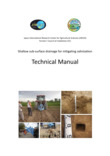Shallow sub‐surface drainage for mitigating salinization Technical Manual

Agricultural productivity in Central Asia increased dramatically during the middle of the 20th century, owing to the large‐scale development of irrigated land. The government has dedicated additional energy and resources enable to farming in arid and semi‐arid regions.Although inadequate water management and poor drainage has led to widespread salinization, among the Central Asia region in Uzbekistan, which has caused serious damage to agricultural production in large area.
Several measures can be taken to mitigate salinization, including water‐saving strategies(e.g., drip, sprinkler), leaching, flushing, laser leveling, dredging of open drainage systems,installation of sub‐surface drainage, and removal of surface saline soil. However, almost all ofthese measures involve initial cost, which is the main barrier to their application. As a result, theonly low‐cost measure that is available to farmers is leaching during the winter after cotton hasbeen harvested. Yet, even the efficacy of leaching has declined by hard soil layer owing tocompaction from the long‐term use of agricultural machinery. Therefore, appropriatecountermeasures are urgently needed.
From 2008 to 2012, the Japan International Research Center for Agricultural Sciences(JIRCAS) had implemented “The Research Project on Measures against Farmland Damage from Salinization”, which focused on farm‐based salinization mitigation strategies that could be usedin areas with high groundwater levels. Ultimately, guidelines were developed, publiclydisseminated through seminars, and distributed to Uzbekistani stakeholders, who had beennegatively affected by salinization.
From 2013 a new research project was initiated by the Joint Research Agreement withFarmers Council of Uzbekistan, it focused on sallow sub‐surface drainage technology to improvethe efficacy of leaching and also drainage blocks that can block the influence from surroundingfields.
This technical manual was compiled as a result of this research activity (from 2013 to 2017),which was subsidized by the Japanese Ministry of Agriculture, Forestry and Fisheries, and isintended to be widely used by government officials and farmers.
In addition, the development of this technical manual was largely supported by the Japanese Ministry of Agriculture, Forestry and Fisheries; Japan Embassy; Japan InternationalCooperation Agency; as well as related research institutions; and by three Water Consumers’Associations (Yangiobad, Axmedov, and Bobur) from the Syrdarya Region of Uzbekistan.
Here, I express my appreciation to all of them for their cooperation.
| 別タイトル | 塩害軽減のための浅層暗渠排水技術マニュアル |
|---|---|
| 刊行年月日 | |
| 作成者 | Japan International Research Center for Agricultural Sciences Farmers’ Council of Uzbekistan (FC) |
| 公開者 | Japan International Research Center for Agricultural Sciences |
| オンライン掲載日 | |
| 国立情報学研究所メタデータ主題語彙集(資源タイプ) | Technical Report |
| 関連するリソース | 異版あり : |
| 言語 | eng |
